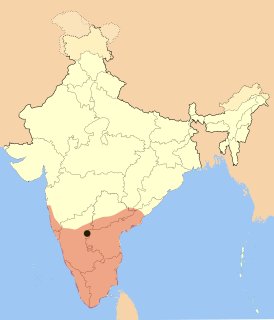 W
WThe Vijayanagara Empire was based in the Deccan Plateau region in South India. It was established in 1336 by the brothers Harihara I and Bukka Raya I of the Sangama dynasty, members of a pastoralist cowherd community that claimed Yadava lineage. The empire rose to prominence as a culmination of attempts by the southern powers to ward off Islamic invasions by the end of the 13th century. At its peak it had subjugated almost all of South India's ruling families and the Sultans of the Deccan region, thus becoming a notable power. It lasted until 1646, although its power declined after a major military defeat in the Battle of Talikota in 1565 by the combined armies of the Deccan sultanates. The empire is named after its capital city of Vijayanagara, whose ruins surround present day Hampi, now a World Heritage Site in Karnataka, India. The writings of medieval European travelers such as Domingo Paes, Fernão Nunes, and Niccolò Da Conti, and the literature in local languages provide crucial information about its history. Archaeological excavations at Vijayanagara have revealed the empire's power and wealth.
 W
WAnegundi previously called Kishkindha is a village in the Gangavathi taluk, Koppal district in the Indian state of Karnataka, It is older than Hampi situated on the northern bank of Tungabhadra River, Huchappayana matha temple, Pampa Sarovar, Aramane, Ranganatha temple, Kamal Mahal, and Nava Brindavana are the major attractions Nimvapuram, a nearby village, has a mount of ash believed to be the cremated remains of monkey king Vaali. Anegundi is best visited along with Hampi, it is part of the world Heritage Site, Hampi, being developed into a world class tourism spot by engaging the locals to sensitise them to their cultural wealth and provide them a means of livelihood. Existing tanks in the village have been redesigned to store clean drinking water and proper drainage facilities developed to keep the surroundings clean and hygienic. The Kishkinda Trust is working on tourism development in Anegundi.
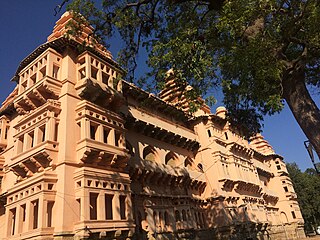 W
WChandragiri Fort is a historical fort, built in the 11th century located in Chandragiri, Tirupati in Andhra Pradesh, India. Although mostly associated with the Vijayanagara Emperors it was built much earlier in 11th century by the Yadava rulers.
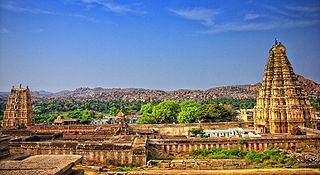 W
WHampi or Hampe, also referred to as the Group of Monuments at Hampi, is a UNESCO World Heritage Site located in east-central Karnataka, India. It is a pilgrimage centre of the Hindu religion.
 W
WKumara Kampana, also known as Kampana Udaiyar, was an army commander and the prince in the Vijayanagar Empire. He was the son of king Bukka I. Kumara Kampana led the successful invasion of the Madurai Sultanate. His exploits form the subject of the Sanskrit epic poem Madhura Vijayam written by his wife Gangadevi.
 W
WThe Kanakachalapathi temple is a 16th-century Hindu temple dedicated to the god Vishnu. It is located in the town of Kanakagiri, in the Gangavathi taluk of Koppal district in the Karnataka state, India. Kanakagiri, known in ancient times as "Swarnagiri" is about 3 km from the district headquarters Koppal city, 380 km north of Bangalore city and 200 km east of Belagavi city.
 W
WKanakagiri is the site of the Indian historical site Kanakachalapathi Temple.
 W
WKondaveedu Fort is a historically significant ancient hill fortress located in Kondaveedu, a village in the Chilakaluripet constituency of Guntur district, Andhra Pradesh, India. The site is located 16 miles west of the city of Guntur. Apart from this main fort, there are two other forts nearby. Efforts are in progress to classify Kondaveedu Fort as a UNESCO World Heritage Site.
 W
WKrishnadevaraya(Kannada: ಕೃಷ್ಣದೇವರಾಯ) was a emperor of the Vijayanagara Empire who reigned from 1509–1529. He was the third ruler of the Tuluva Dynasty and is considered to be its greatest ruler. He possessed the largest empire in India after the decline of the Delhi Sultanate. Presiding over the empire at its zenith, he is regarded as an icon by many Indians. Krishnadevaraya earned the titles Kannada Rajya Rama Ramana, Andhra Bhoja and Mooru Rayara Ganda. He became the dominant ruler of the peninsula of India by defeating the Sultans of Bijapur, Golconda, the Bahmani Sultanate and the Gajapatis of Odisha, and was one of the most powerful Hindu rulers in India. Indeed, when the Mughal Emperor Babur was taking stock of the potentates of north India, Krishnadevaraya was rated the most powerful and had the most extensive empire in the subcontinent.
 W
WKrishnagiri is a city in the state of Tamil Nadu, India, and it serves as the administrative headquarters of Krishnagiri District formed in 2004. It is located at the bottom of Syed Basha Hills, and the city is fully surrounded by hill rocks. It is located 250 km from Chennai, 45 km from Dharmapuri, and 90 km from Banglore. Krishnagiri is known as "Mango Capital of India" as mangoes are cultivated as the main crop, and the land here is extremely fertile with rich access to fresh water making it amenable to growing crops. Krishnagiri is a rapidly growing city and is the site of significant business and residential development. The Krishnagiri Dam was built in 1967. Krishnagiri is currently undergoing expansion and a variety of small-scale industry zones are being set up. As of 2011, the city had a population of 199,657.
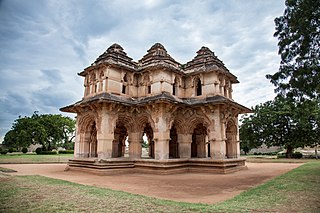 W
WLotus Mahal or Chitrangi Mahal is an important secular structure in Hampi, India. The Lotus Mahal is an example of Indo-Islamic style of architecture and is a two storied structure built in Rubble masonry and finely plastered. The structure was used as residue place for royal family of the Vijayanagara Empire.
 W
WMadhurā Vijayam, meaning "The Victory of Madurai", is a 14th-century C.E Sanskrit poem written by the poet Gangadevi. It is also named Vira Kamparaya Charitham by the poet. It chronicles the life of Kumara Kampana, a prince of the Vijayanagara Empire and the second son of Bukka Raya I. The poem describes in detail, the invasion and conquest of the Madurai Sultanate by the Vijayanagara empire.
Malliswari is a 1951 Indian Telugu-language historical romance film produced and directed by B. N. Reddy under his banner Vauhini Studios. N. T. Rama Rao and P. Bhanumathi star as a couple – Nagaraju and Malliswari – who are separated by Malliswari's greedy mother. Malliswari is sent to the king's palace according to the custom of "Rani Vasam", a tradition during the Vijayanagara Empire wherein young women were fetched to the palace with an offering gold and jewellery to their parents. The rest of the film focuses on the consequences faced by Nagaraju when he, against all rules, surreptitiously enters the palace to meet Malliswari.
 W
WThe Military of Vijayanagara supported the Vijayanagara Empire in particular with regard to the empire's long-lasting rivalry with the Bahmani Sultanate. Besides a large standing army, the Vijayanagara rulers also maintained a powerful navy. This helped make the Viayanagara empire the most centralised polity ever to have emerged in South India. However, a major portion of the imperial income was committed to military purposes, straining the economy.
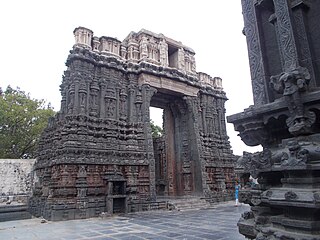 W
WPemmasani Ramalinga Nayudu I was a member of the Pemmasani Nayak clan in the 15th century Vijayanagara Empire in southern India. He developed the hamlet of Tallapalle, renaming it to Tadipatri upon orders of the Vijayanagara emperor. He built a fort in the town and the Bugga Ramalingeswara Temple. Another temple to Obaleswara in Kurnool District is also attributed to him.
 W
WPemmasani Timmanayudu II was a member of the Pemmasani Nayaks. He was the son of Pemmasani Ramalinga I and a contemporary of Vira Narasimharaya and Krishnadevaraya. After the death of his father, Timmanayudu went to inform the Vijayanagara Emperor of the progress made in developing the Rayalaseema region. The emperor was so pleased with what he heard that he made Timmanayudu the commandant of the Gandikota Fort on behalf of Saluva Govindaraja, its governor. Then, Timmanayudu gave control of Yadiki and Tadipatri, which were previously controlled by his ancestors, to a relative and shifted to Gandikota.
 W
WAchyuta Deva Raya was a ruler of a Vijayanagara Empire of South India. He was the younger brother of Krishna Deva Raya, whom he succeeded in 1529.
 W
WDeva Raya I was a king of the Vijayanagara Empire. After Harihara II died there was a dispute between his sons over the throne in which Deva Raya I eventually emerged victor. He was a very capable ruler noted for his military exploits and his support to irrigation works in his kingdom. He modernized the Vijayanagara army by improving the cavalry, employed skilled archers of the Turkish clan and raised the fighting capacity of his bowmen and horses from Arabia and Persia. Of Deva Raya I, the Italian traveler Nicolo Conti, who visited Vijayanagara in c.1420, described thus: "In this city, there are 90,000 men fit to bear arms... their king is more powerful than all the kings of India". Conti also noted that the royal city had grown to a circumference of 60 mi. Deva Raya I was a patron of Kannada literature and architecture. Madhura, a noted Jain poet was in his court and wrote in Kannada the Dharmanathapurana on the life of the fifteenth Jain Tirthankar (Dharmanatha), and a poem in eulogy of Gommateshvara of Shravanabelagola. The noted Hazare Rama temple, an excellent example of Deccan architecture was constructed during his rule. One of Deva Raya's queens Bhima Devi was a disciple of the Jain guru Abhinava Charukirti Panditacharya. She was a devotee of Shantinatha, 16th Jain tirthankara and built a temple at the Mangayi Basti in Shravanabelagola.
 W
WDeva Raya II was an emperor of the Vijayanagara Empire. The greatest of the Sangama dynasty rulers, he was an able administrator, warrior, and scholar. He authored well-known works in the Kannada language and in the Sanskrit language. He was patron to some of the most noted Kannada poets of the medieval period, including Chamarasa and Kumara Vyasa, the Sanskrit poet Gunda Dimdima, and the noted Telugu language poet Srinatha, whom the king honored with the title Kavisarvabhauma. He supported development in secular literature as well as the noted South Indian mathematician Parameshvara, from the Kerala school of astronomy and mathematics lived in his empire.
 W
WVenkata III was the grandson of Aliya Rama Raya. Venkata III belonged to the Telugu Family and became the King of Vijayanagara Empire from 1632–1642. His brothers in law were Damarla Venkatappa Nayaka and Damarla Ayyappa Nayaka, both sons of Damarla Chennapa Nayakadu
 W
WThe period of the Vijayanagara Empire is considered an age of prosperity in South India in the 14th century CE. Many travelogues written by visitors, ambassadors and authors of that time provide ample proof of a vibrant era. Agriculture was the main sustenance and the Tungabhadra was the life blood of the capital city.
 W
WSrikalahasti Temple is located in the town of Srikalahasti, in the state of Andhra Pradesh, India. It is one of the most famous Shiva temples in South India, and is said to be the site where Kannappa was ready to offer both his eyes to cover blood flowing from the Siva linga before the Siva stopped him and granted him moksha.
 W
WThe Teru Malleshvara Hindu temple is a Vijayanagara era temple in Hiriyur town near the historically important Chitradurga city in the Indian state of Karnataka. Hiriyur is situated on the right bank of the Vedavati river. The "Teru Malleshvara" fair is celebrated annually for a week starting from the full moon in January or February. The Teru Malleshvara temple is a protected monument under the Karnataka state division of the Archaeological Survey of India
 W
WVellore Fort is a large 16th-century fort situated in heart of the Vellore city, in the state of Tamil Nadu, India built by Vijayanagara kings. The fort was at one time the headquarters of the Aravidu Dynasty of the Vijayanagara Empire. The fort is known for its grand ramparts, wide moat and robust masonry.
 W
WThe Venugopalaswamy Temple, dedicated to a form of the Hindu god Vishnu is located inside the Devanahalli Fort in the town of Devanahalli. It is a town in the Bangalore Rural district, Karnataka state, India and is located 35 kilometres (25 mi) to the north-east of Bangalore, the state capital. The Venugopalaswamy temple is constructed in the Dravidian style and belongs to the post Vijayanagara empire period. The temple is a protected monument under the Karnataka state division of the Archaeological Survey of India.
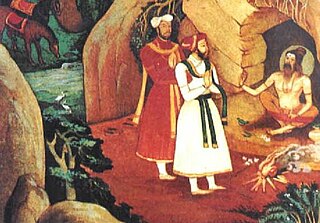 W
WVidyaranya is variously known as a kingmaker, patron saint and high priest to Harihara I and Bukka Raya I, the founders of the Vijayanagara Empire. He was the 12th Jagadguru of the Śringeri Śarada Pītham from 1380-1386.
 W
WVijayanagara was the capital city of the historic Vijayanagara Empire. Located on the banks of the Tungabhadra River, it spread over a large area and included the modern era Group of Monuments at Hampi site in Ballari district and others in and around that district in Karnataka, India. A part of Vijayanagara ruins known as Hampi have been designated as a UNESCO world heritage site. Vijayanagara is in the eastern part of central Karnataka, close to the Andhra Pradesh border.
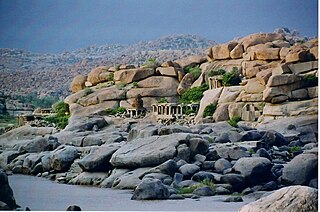 W
WThe City of Vijayanagara was the urban core of the imperial city and the surrounding principalities of the capital of the Vijayanagara empire during the 14th century to 16th century CE. Notes by foreign travellers such as Abdur Razzak, the Persian who visited Vijayanagara in 1440, mention seven fortifications before the gates to the royal palace. The large area between the first and third fortifications contained agricultural fields, gardens and residences. The notes of Robert Sewell describe countless shops and bazaars (markets) filled with people from different nationalities between this fortification and the palace.
 W
WThe Vijayanagara Empire from 1336–1646, was situated in Southern India and had a complex currency system that was used after the Empire ceased to exist.
 W
WThe Vijayanagara metropolitan area comprised the urban core of the imperial city and the surrounding principalities of the capital of the Vijayanagara empire in the time period spanning early 14th. century to the middle of 16th. century C.E.
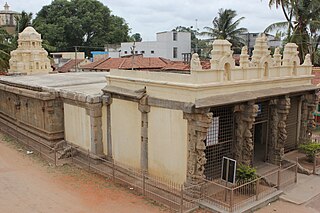 W
WThe Vijayanarayana Temple is located in the town of Gundlupet of Chamarajanagar district, Karnataka state, India. The temple dates back to the 10th century rule of the Western Ganga Dynasty, though it has received continuous patronage from later kingdoms as well, up to the 15th century Vijayanagara period. Tradition has it that the Hoysala Empire King Vishnuvardhana was responsible for the consecration of the deity Vijayanarayana, a version of the Hindu god Narayana.
 W
WVirupaksha Raya II ( born - 1445) was a king of the Vijayanagara Empire from the Sangama Dynasty